 
Chuckjav
Member
Username: Chuckjav
Post Number: 75
Registered: 09-2007
| | Posted on Wednesday, September 19, 2007 - 10:49 pm: |    |
Anyone remember that monstrous natural gas storage tank near Schaefer and Fenkell; I'm pretty sure it was demolished in 1969...possibly '70.
Talk about an eyesore!
Any truth to the stories about National Guard and US Army guarding the tank against saboteurs during the 1967 Riot? |
 
Ray1936
Member
Username: Ray1936
Post Number: 1955
Registered: 01-2005
| | Posted on Thursday, September 20, 2007 - 12:36 pm: |    |
Yup, remember it well. Large neon sign near the top that said, "Gas is best!" Before 1950, the sign was more elaborate, reading "Gas is best, the automatic gas way!"
Just east of the tank was a great softball field with organized leagues that played nearly nine months of the year.
I don't know about the guarding of the tank during the riot, but it doesn't sound far-fetched to me. There was another one on the east side near City Airport which had a red and white checkerboard top to warn aircraft, and there was a smaller one in Dearborn just off of Schaefer and Miller Road. All were taken down after additional natural gas pipelines were completed ending the need for storage.
I guess we got our first TV set in 1948 when broadcasting was but a year old. As we lived practically in the shadow of that tank, our picture had a 'ghost', or double image, no matter what kind of antenna we used then. The signal bounced off'n the tank and back to our antenna resulting in the twin picture. Far cry from the cable HDTV I have now!  |
 
Chuckjav
Member
Username: Chuckjav
Post Number: 77
Registered: 09-2007
| | Posted on Thursday, September 20, 2007 - 1:56 pm: |    |
Ray....Was the DSR yard located on Schaefer at Fenkell? I can remember riding back to Oak Park from Tiger Stadium (Grand River to Schaefer bus) back in '68; the driver stopped the bus at/near Fenkell and ran into a big building to pick up some paperwork. I'm also recollecting Abrams Moving & Storage in that area too.
Did you ever spend time at the Schaefer Branch of the Public Library? That was a nice place to be.
A little further to the east was good old Butzel Field & Pool; I life guarded there for a few summers. I remember a fairly old cemetary beside Butzel.
Last time I was in that area, about five years ago, I was really impressed with all the small factories and shops...still doing business (along Fenkell, between Schaefer...east to just about Wyoming). |
 
Quozl
Member
Username: Quozl
Post Number: 1484
Registered: 07-2005
| | Posted on Thursday, September 20, 2007 - 1:58 pm: |    |
Hell yeah I remember it Chuckjav. We went to Rina's Pizza across the street from the storage tank all the time in the 60's and early 70's. |
 
Ray1936
Member
Username: Ray1936
Post Number: 1957
Registered: 01-2005
| | Posted on Thursday, September 20, 2007 - 2:18 pm: |    |
The DSR storage area on Schaefer was at Lyndon, south of Fenkell. I think it was called the Coolidge Terminal, probably because Schaefer becomes Coolidge north of eight mile, but I'm guessing.
The library was actually named the Monnier Branch library. It was originally the Monnier grade school until about 1935 when the new Monnier was opened at Ward and Schoolcraft, and was then converted to the branch library. Yeah, spent a lot of time there. Belonged to a stamp club that met in the basement; was my favorite pastime way back then. I learned more geography from that hobby than from any class I ever took. To this day I can remember that a Zloty is a Polish unit of currency.
Wish I could remember the name of that little cemetery next to Butzel field. Walked by it hundreds of times. Google aerial views shows it to be in reasonably good shape yet. |
 
Chuckjav
Member
Username: Chuckjav
Post Number: 79
Registered: 09-2007
| | Posted on Thursday, September 20, 2007 - 3:29 pm: |    |
Ray.....yes, Coolidge - I remember that from Oak Park; is Schaefer also called Coolidge in Dearborn? My older brother told me the story of how the Monnier Branch was at one time a school; I seem to remember a very nice wooden staircase there....or, maybe I am thinking of the DPD Schaefer Precinct house?
Quozl.....I think I do remember Rina's; don't remember stopping by. Our family's favorite pizzeria was "Jo-Ed's" on Plymouth, near Parker Elemetary. There was a little pet shop nearby; I would sell them baby hamsters...$1.00 each...big-time moola for me back in '69. Pretty funny now to think of me, as an eleven year-old hamster mill operator.
Do you folks remember Rollie Barrett Chrysler Plymouth (Ward & Grand River)....there was also an "Auto Drive-Away" store across the street - had a goofy car in the window as an advertisement...it had two front-ends!
I also remember all the business establishments along Grand River, between Ward and Schaefer. They were all abandoned by 1969-70....in preparation for the Jeffries Freeway coming through.
One in particular, a Dodge Dealership, still had the 1968 "Dodge Fever Reliever" posters in the window.
Memories of long ago. |
 
Ray1936
Member
Username: Ray1936
Post Number: 1959
Registered: 01-2005
| | Posted on Thursday, September 20, 2007 - 11:26 pm: |    |
Schaefer is still Schaefer in Dearborn.
Good memories! |
 
Ray1936
Member
Username: Ray1936
Post Number: 1999
Registered: 01-2005
| | Posted on Saturday, September 29, 2007 - 7:06 pm: |    |
Double dipping....but here's a repeat of the photo I posted on a different thread.
Mich Con gas tank that was at Schaefer and Coolidge. Photo from 1938 taken from one mile away. House in background is on Foley street, just south of Fullerton.
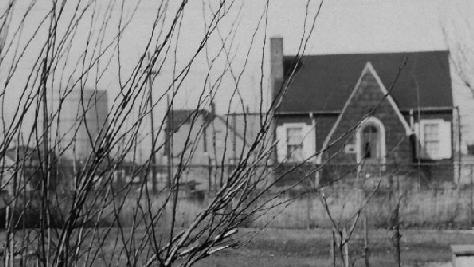
|
 
Mikeg
Member
Username: Mikeg
Post Number: 1195
Registered: 12-2005
| | Posted on Sunday, September 30, 2007 - 11:53 am: |    |
Here is a July 1942 color photo taken from the top of the Maccabees Insurance Building at Woodward and Warren (now the DPS Building). Five miles away at the upper left is the natural gas storage tank that was adjacent to Detroit City Airport.
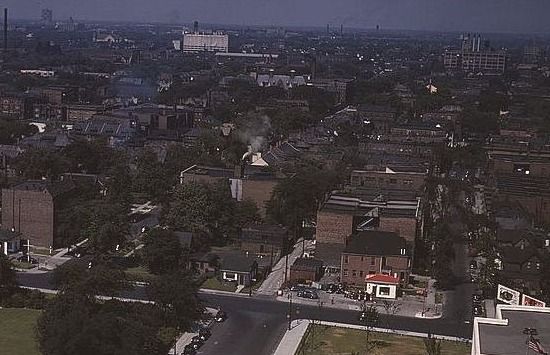
The "T" intersection in the foreground is Farnsworth and John R. The gas station and billboards at the lower right were located at the intersection of John R and Theodore. |
 
Bc_n_dtown
Member
Username: Bc_n_dtown
Post Number: 28
Registered: 09-2006
| | Posted on Sunday, September 30, 2007 - 1:27 pm: |    |
Here are a few photos of a couple of those natural gas storage tanks in discussion.
The first two photos are of the tank located to the north of the DSR Coolidge Terminal, near Schaefer and Lyndon. The third photo shows the two storage tanks that were located on Epworth, between Tireman and W. Warren. A Clairmount streetcar is seen in the foreground.
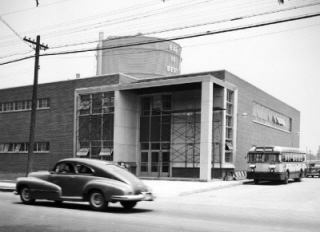
Coolidge Terminal - 1948 (WSU Virtual Motor City photo)
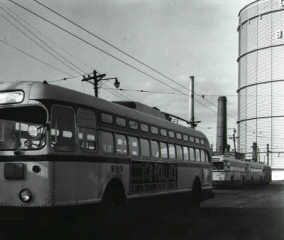
Coolidge Terminal yard (c. late-1950's) Actually, these electric trolley-buses were the main focus of this photo, the storage tank just happen to be in the shot.
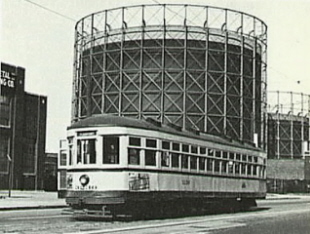
Epworth south of Tireman - 1948 (Thomas C. Van Degrift photo)
(btw--in response to a few earlier comments in this thread.
1) The DSR Coolidge Terminal was so named because when the original terminal was built back in 1928, Schaefer Road in Detroit was known as Coolidge Highway. As a practice, the DSR tended to name a number of its carhouses and bus garages after the streets where they were located, e.g. Shoemaker Terminal, Jefferson Carhouse, Gratiot Carhouse, Woodward Carhouse, Wyoming Terminal, etc.... Coolidge Highway was later renamed Schaefer sometime around 1931.
2) I also noticed that on my 1925 Detroit street map, the present-day Schaefer Road in Detroit was known as Monnier Road before it was known as Coolidge. Could that possibly explain the library branch and school mentioned here bearing that name??? |
 
Mikem
Member
Username: Mikem
Post Number: 3489
Registered: 10-2003
| | Posted on Sunday, September 30, 2007 - 1:31 pm: |    |
Detroit City Gas/MichCon had seven storage tanks around the city: At City Airport (Lynch & French), on the west side of the US Rubber plant (Wight & Meldrum), on the east side of the Ambassador Bridge (Jefferson & 21st), in Melvindale on the west bank of the Rouge (Greenfield & Allen), on the south side of Hamtramck (St Aubin, south of Clay), on the north side of the Lincoln factory (Tireman & Epworth), and the one at Schaefer & Lyndon.
(Message edited by MikeM on September 30, 2007) |
 
Ray1936
Member
Username: Ray1936
Post Number: 2003
Registered: 01-2005
| | Posted on Sunday, September 30, 2007 - 1:53 pm: |    |
Great photos, Bc. Yeah, Peter C. Monnier was a large landholder in that area when it was farmland, and he donated property to the city for the original Monnier School, which later became the library when the new building a quarter mile away was opened. I would not be surprised that the road was named for him for a while. |
 
Ray1936
Member
Username: Ray1936
Post Number: 2011
Registered: 01-2005
| | Posted on Sunday, September 30, 2007 - 8:41 pm: |    |
Just checked the 1920 census. In that year, Peter C. Monnier was 89 and living on Monnier Avenue at Grand River. He was born in France, and emigrated in 1848. A daughter, 59 year old Clara M. Whiting, lives with him. Both state they are widowed.

Going back ten years to 1910, he appears on Monnier Street, and his wife, Catharine, is in the home. Catharine was 76 in 1910, and she states she had nine children, seven of whom are still living. Peter states his occupation is "Farmer".

In 1900, he appears in Chesterfield Township in Macomb county with his wife and four of his nine children, occupation "Farmer". So it would appear that between 1900 and 1910, Peter saw the light and became a west sider.
He does not appear in the 1870 or 1880 census reports; the 1890 does not exist. |
 
Mikem
Member
Username: Mikem
Post Number: 3490
Registered: 10-2003
| | Posted on Sunday, September 30, 2007 - 10:48 pm: |    |
The Detroit City Gas Co called their gas making/storage locations "Stations". Station A, their first gas production plant was on the west side of the Ambassador Bridge, not east side as I said earlier:
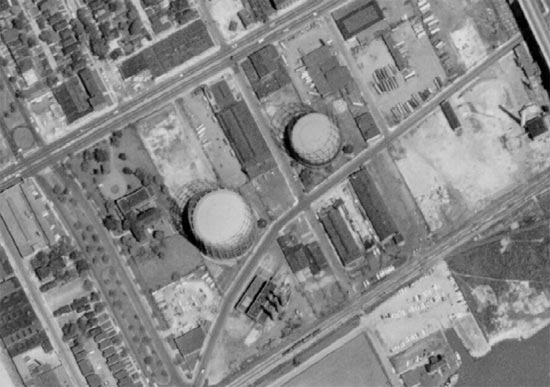
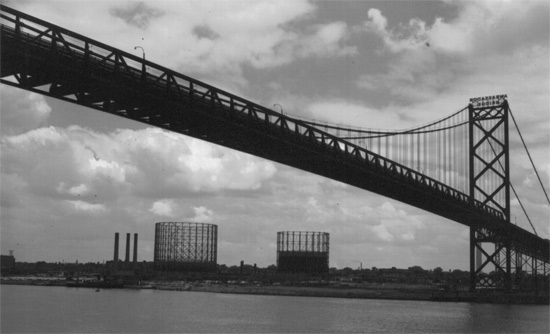
Station B was the one near the Uniroyal plant:
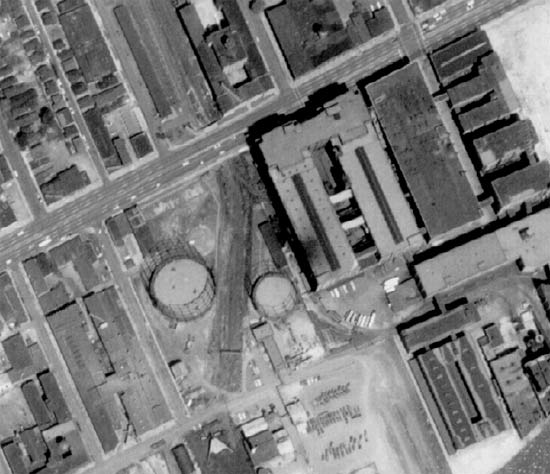
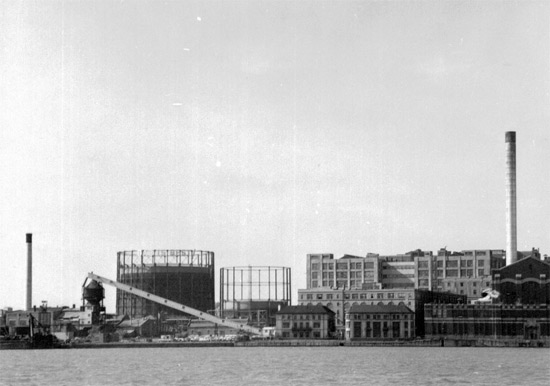
The one in Hamtramck was Station G:
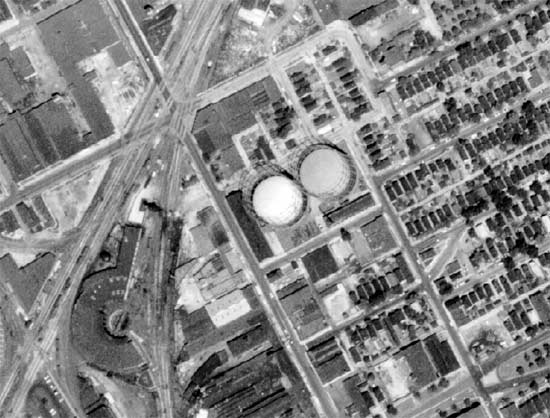
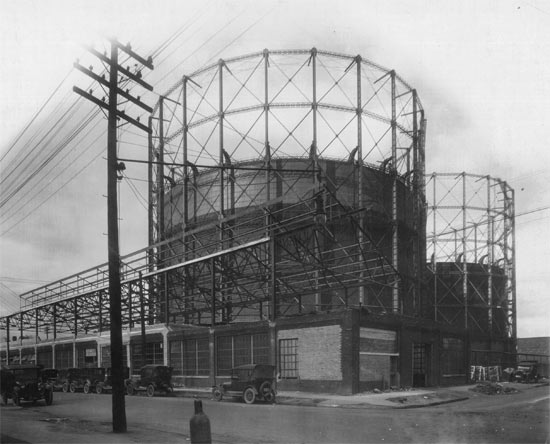
The one near City Airport was the Lynch Station:
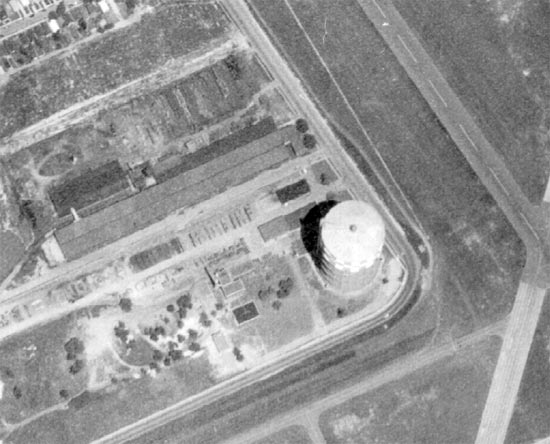
The Schaefer-Lyndon location was the Coolidge Station:
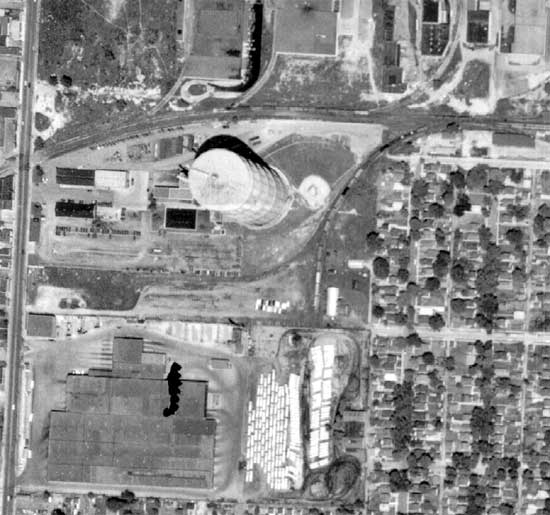
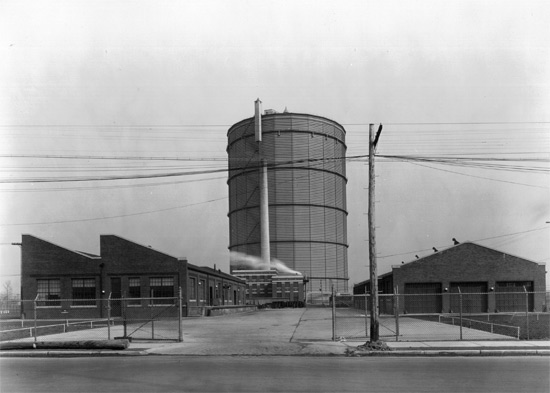
The Melvindale location was the Rouge Station:
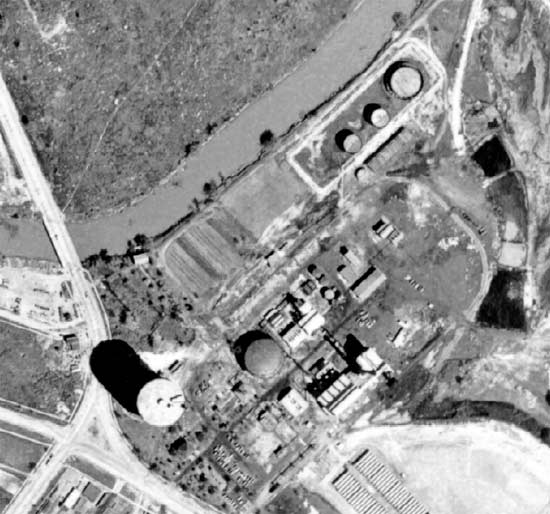
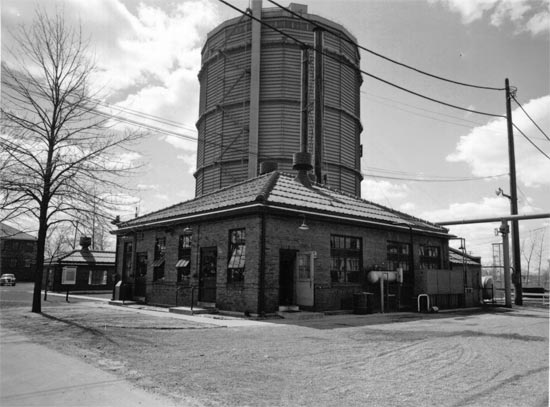
The one near the Lincoln factory was the Tireman Station:
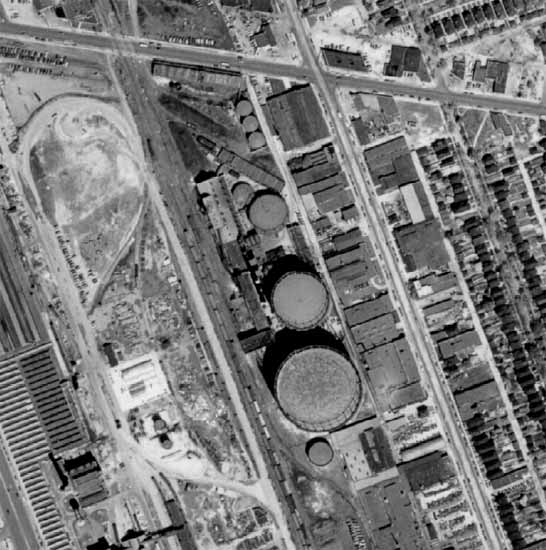
|
 
Burnsie
Member
Username: Burnsie
Post Number: 1160
Registered: 11-2003
| | Posted on Sunday, September 30, 2007 - 10:51 pm: |    |
Isn't there still a gas storage tower at the Rouge Plant? |
 
Mikem
Member
Username: Mikem
Post Number: 3491
Registered: 10-2003
| | Posted on Sunday, September 30, 2007 - 11:01 pm: |    |
No, that one is gone; not sure when they took it down. The Rouge Station pictured above is not the same one you're thinking of; it's upstream and across the river. |
 
Gsgeorge
Member
Username: Gsgeorge
Post Number: 206
Registered: 08-2006
| | Posted on Sunday, September 30, 2007 - 11:25 pm: |    |
quote:The signal bounced off'n the tank and back to our antenna resulting in the twin picture.
Ray, that's incredible, I've never heard of that before.
Interesting thread, great shots Mikem! |
 
Livernoisyard
Member
Username: Livernoisyard
Post Number: 4135
Registered: 10-2004
| | Posted on Sunday, September 30, 2007 - 11:31 pm: |    |
Ghost reception was very common during the early days of TV. People living near the flight paths of airplanes experience them regularly if they're watching conventional TV. |
 
Ray1936
Member
Username: Ray1936
Post Number: 2013
Registered: 01-2005
| | Posted on Sunday, September 30, 2007 - 11:33 pm: |    |
Let me jump on that Coolidge Station shot:
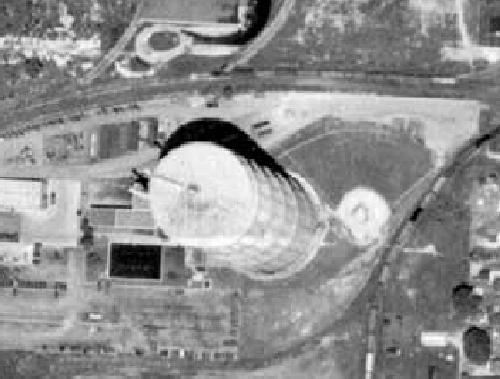
You can see the softball field to the east of the tank. Great softball leagues played there. No lights, but it was a great field. There was a nice set of bleachers along each foul line, also, and they were frequently packed full.
Then that dark rectangle on the southwest side was a water-filled pool that was used to practice fishing rod casting. Floating aluminum tubes bent into a circle were the targets. This was for the old rod and reel type outfits, the spinning rod hadn't yet been invented. But the anglers would be there day in and day out practicing dropping their dummy lures in those circles.
The railroad track just east of the softball field was surrounded by a marshy, swampy area, full of frogs.
The whole area was fun for kids back then, 'cept for getting chased by the RR dicks when you messed with their boxcars......... |
 
Burnsie
Member
Username: Burnsie
Post Number: 1164
Registered: 11-2003
| | Posted on Sunday, September 30, 2007 - 11:45 pm: |    |
The Rouge gas tower I'm thinking of had a big Ford oval, and was standing at least into the '90s (it can be seen in the Detroit "Visions of the Eagle" book). Maybe it was actually a coke gas storage facility?? |
 
Livernoisyard
Member
Username: Livernoisyard
Post Number: 4136
Registered: 10-2004
| | Posted on Monday, October 01, 2007 - 12:25 am: |    |
The Rouge tower (recently demoed, BTW) most likely was a coke gas facility--and some of the others locally were probably for coke, too.
Back during 1957 and 1958 in Milwaukee, there were two such towers clearly visible at Marquette U. HS, around 31st in the Menominee River valley a few blocks to the SE. These towers might have be sectionalized because during 1958, one tower started becoming reduced in height.
So, either a large section or smaller layers were removed as the city switched from coal gas to natural gas after the gas pipelines entered Milwaukee around 1950. Gradually, both of those two towers were shortened and eventually totally removed. I remember that the coal companies there were still pushing coke for replacing coal for residential use just before 1960. I do not remember any coke TV/radio ads after that. Detroit was probably connected a few years later when the pipelines arrived there.
(Message edited by LivernoisYard on October 01, 2007) |
 
Mikem
Member
Username: Mikem
Post Number: 3493
Registered: 10-2003
| | Posted on Monday, October 01, 2007 - 12:38 am: |    |
What sound did the tank make when you hit it with a foul ball?
After a long legal and financial battle, the longest pipeline in the world was built from the gas fields of Kansas to Detroit in 1936. The Panhandle Eastern Pipe Line Company's order for steel to build it was the largest single steel purchase ever made from the steel industry. The arrival of Hugoton Field gas in Detroit put the local gas plants out of commission overnight. I think there might have been a brief period during the war when they were put back in use, but since then, I assume the function of these large tanks was also obsolete.
Burnsie - there were two large tanks at the Rouge complex:
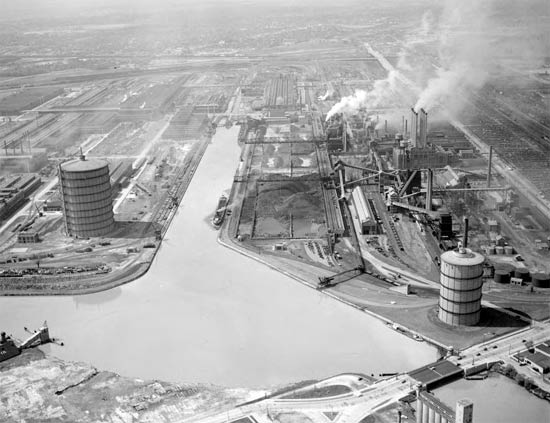
The larger one was dismantled in the late 1950s; the smaller one next to the Dix Avenue bridge lasted much longer. I'm not sure which one was older. I always thought the smaller one was a coke gas tank but I'm not so sure anymore.
Ford took gas directly from Panhandle Eastern when it became available, but I think that was a source of legal battles with Detroit City Gas and the Michigan Public Service Commission, which resulted in intermittent deliveries from Panhandle while the cases were heard. Maybe the tanks, or at least the larger one, was used to store gas delivered by either Panhandle or City Gas during times of suspended service due to the legal challenges? |
 
Chuckjav
Member
Username: Chuckjav
Post Number: 135
Registered: 09-2007
| | Posted on Monday, October 01, 2007 - 10:31 am: |    |
Ray....I enjoyed your description of the area surrounding Coolidge Station; the idea of folks practicing their fly casting...swamps with frogs - in the city of Detroit....totally mind boggling. |
 
Aarne_frobom
Member
Username: Aarne_frobom
Post Number: 64
Registered: 10-2005
| | Posted on Monday, October 01, 2007 - 11:20 am: |    |
I enjoyed seeing pictures of the expandable coal-gas tanks, and how they vary in height from one picture to the next.
Not everyone knows how these things worked. The tank top rose and fell inside the steel framework, guided by rollers. As the gas was manufactured, it would be pumped into the tank, and the roof of the tank would rise. After the roof rose, it would pull up the telescoping cylinder sections in succession. The seal between the sections was accomplished by a water-filled gutter around the lower edge of each segment; the upper edge of the next segment would hook into it as it was pulled up. The bottom segment of the tank was always full of water, so that the bottom of the partially-lifted lowest segment would always be sealed. The weight of the roof would automatically regulate the line pressure.
The tanks often looked rusty because the lower segments were frequently submerged.
These tanks were called gasholders in this country, gasometers in Europe. In the 19th century, masonry was usually used instead of the steel framework. Somewhere in Germany, maybe Berlin, a row of four of these has recently been rehabbed into a shopping mall. |
 
Ray1936
Member
Username: Ray1936
Post Number: 2016
Registered: 01-2005
| | Posted on Monday, October 01, 2007 - 11:48 am: |    |
I once heard a gas company employee state they operated like giant pistons. I guess that's accurate.
Can't remember the sound of a ball hitting the tank, but there were catwalks around the tank at various levels, and more than one softball ended up there. Wonder who got them all? |